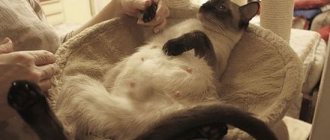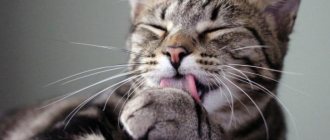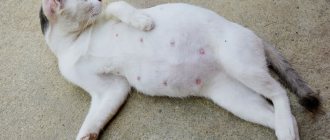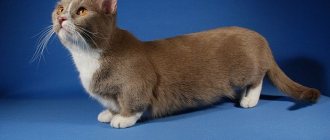Home » Useful Information
How many nipples does a cat have? This question is not only interesting, but also important. It can be of concern not only because of curiosity, but also in connection with the cat’s pregnancy and her upcoming feeding of kittens, as well as for the early detection of diseases of the mammary glands.
- 2 How many nipples should cats have?
2.1 In cats
- 4.1 Mastitis
4.1.1 Video: causes, symptoms and treatment of mastitis
- 4.2.1 Video: causes, symptoms and treatment of mastopathy
- 4.3.1 Video: causes, symptoms and treatment of mammary cancer in cats
Features of the structure of nipples in cats
The nipples of an adult cat are small cone-shaped structures located in pairs and symmetrically along the line of the abdomen and sternum. They are small in size - protruding only 2-3 mm above the skin. It is quite difficult to detect mammary glands in furry and long-haired animals - they are practically invisible, they are found and checked by palpation.
Cats' nipples are located symmetrically, starting from the thoracic region and ending with the inguinal region.
It is worth noting that the nipples themselves are not covered with hair, nor is the small circle around them with a diameter of no more than 1 cm.
When a cat begins lactation, its mammary glands increase significantly in size. On average, they protrude 8 mm above the surface of the animal’s body. This period does not last long - about a month. Kittens receive milk through special channels located in the nipples. Their number varies from 5 to 8 depending on the age and breed of the animal. After the end of lactation, the cat's nipples quickly return to their original state.
Pregnant cats' nipples become slightly larger
Cats, just like cats, have nipples on their bodies. This may seem strange, because the main physiological purpose of these organs is to feed offspring, which cats, for obvious reasons, do not do. However, the presence of nipples in males is a common occurrence in mammals.
The fact is that they are formed in embryos during the period of intrauterine development, when the genital organs are not formed. The lactation process in a cat is triggered by the release of a special hormone that is not produced in males. Therefore, although cats have nipples, they are, in fact, presented in the form of a kind of rudiment (an organ that has lost its original meaning).
Some people try to determine the gender of a cat by the presence of nipples. It is pointless. The existence of cats without nipples has not been officially registered.
Causes of seals
The main reasons that lead to the appearance of swelling can be identified:
- Negative effects on the animal’s body from excessive environmental pollution;
- Unbalanced diet, presence of low-quality food in the diet;
- Hereditary predisposition to the development of pathologies;
Often the reason why a cat has swollen mammary glands after kittens lies in the early separation of the offspring from the mother. Most often, this condition does not have a negative effect on the pet’s body and goes away on its own over time. In this case, it is recommended to express milk both independently and with the help of a veterinarian. You can also make lotions at room temperature from a decoction of oak bark or chamomile.
How many nipples should cats have?
Most felines have 8 nipples (4 pairs). Moreover, they are located in pairs - opposite each other along the line of the sternum and the middle of the abdomen. Veterinarians distinguish three groups of nipples, depending on their location on the animal’s body:
- inguinal;
- abdominal;
- chest
Some wild relatives of cats have 4 nipples, a total of 2 abdominal pairs. These are, for example, tigers and lions. They rarely have more than 4 kittens in a litter, and if this happens, the 5th cub usually dies due to lack of nutrition.
It is worth noting that during lactation the mammary glands of the abdominal group secrete the largest amount of milk. They are also the most susceptible to various kinds of diseases.
In cats
Despite the fact that nipples in cats have no practical significance, their location and number in a male is exactly the same as in a female. But it is still worth noting that, being a rudiment, the nipples of cats are smaller and undeveloped, so it is very difficult to notice them, especially in long-haired representatives. In this regard, it may seem that cats have smaller nipples than cats, but this is not so.
Characteristic symptoms
The main symptoms appear when the disease has already entered the advanced stage. At this stage, the animal’s general well-being worsens and its appearance changes. The tumor may appear as single or multiple nodes. The inguinal and axillary lymph nodes are inflamed. The lesion may involve several lobes of the mammary gland. Sometimes its true size can only be assessed after shaving the fur over a fairly large area of the body. The main clinical signs at this stage are:
- the neoplasm is significant in size;
- there is quite severe inflammation of the surrounding tissues;
- the cat is in quite a lot of pain;
- body temperature may rise;
- the animal loses weight sharply, there is no appetite;
- Bleeding and discharge of pus from the opened tumor are possible.
If a cat's mammary gland is swollen and painful, this is not always associated with cancer. Very often, some non-tumor conditions of the mammary glands have similar signs. Basically, these are hyperplasias (tissue growths) of various etiologies and some other conditions:
- hyperplasia of the gland ducts;
- breast cysts;
- lobular hyperplasia;
- fibroadenomatous hyperplasia;
- false pregnancy;
- true pregnancy;
- consequences of the administration of progesterone hormone drugs.
Deviations from normal indicators of the number of nipples
There are a number of exceptions that go beyond the normal number of nipples:
- there may be more or less than 8;
- they are not located parallel to each other;
- not every one of them has a pair.
Nipples that do not have a pair are usually underdeveloped and do not have mammary gland ducts. During pregnancy, they do not swell and remain in their normal state.
Nipples may differ in size and even color from each other. These are individual characteristics of a particular pet that do not pose any harm to health. For feeding kittens, it is not the number of nipples that is important, but their functionality.
There is an opinion that there are some deviations from the norm in the number of nipples in cats of different breeds. Indeed, say, hairless cats (Sphynxes) often have an odd number and an asymmetrical arrangement. However, this is not even considered a fault of the breed.
In general, there is no direct relationship between the number of nipples and the breed of cat.
Postoperative period: animal care
A caring owner should know what to do in the postoperative period. His main task is to accurately follow all medical recommendations:
- The most important condition is to create all the conditions for the animal to recover as quickly as possible. He needs rest for successful rehabilitation.
- The diet is compiled together with the attending physician. Only recommended foods or feeds are allowed and given in moderation. There should be no deviations from the dietary regime.
- Timely treatment of seams and surrounding tissues is important.
- Postoperative drug therapy will help create protection against infections to eliminate the possibility of complications.
- Protective bandages and blankets should be used to prevent the animal from injuring the operated area.
At the slightest hint of postoperative complications (the stitches have ruptured and pus appears, or the temperature has risen), you must immediately take the animal to the clinic.
Diseases of the nipples in cats and kittens
Often cats have underdeveloped mammary glands, when there is not enough milk or it is not completely released. The reason for this anomaly may be:
- hormonal disorders;
- intrauterine developmental defects;
- past infectious diseases.
This in itself is not a disease unless it leads to more serious complications. This condition is much more important for the offspring of a mother cat. In stray animals with underdeveloped mammary glands, the babies born may be delayed in development due to lack of milk or die; pets have to be artificially fed.
Unfortunately, animal nipples can be susceptible to various diseases, some of which pose a direct threat to the life and health of the pet.
Mastitis
There is an opinion that inflammation of the mammary glands - mastitis - can only occur in cats during lactation. This is not so, the disease can also affect a cat that is not burdened with offspring, and has never given birth at all. It is extremely rare, but it happens that this disease affects cats. The causes of mastitis are as follows:
- Lactostasis is stagnation of milk in the mammary glands, which occurs due to early weaning of kittens from a cat.
- Hormonal disruptions - usually occur as a result of estrus that does not end with fertilization.
- Mechanical injuries and bruises of the mammary glands.
The disease manifests itself in the form of swelling and redness of the nipples, and their soreness. In advanced cases, blood mixed with pus may be released from them.
With mastitis, your cat's nipples and the area around them become swollen, hardened, and redder.
It is important to treat mastitis under the supervision of a veterinarian. Home therapy involves expressing excess milk. Baths and lotions made from infusions of oak bark, chamomile, and sage, which have a bactericidal effect, will ease the condition.
Drug treatment is prescribed by the doctor, based on the severity of the disease and the condition of the animal. For mastitis, injections are given:
- Mastomethrina;
- Katozala;
Catozal is a drug that stimulates metabolic processes in the body of animals; one of the indications is mastitis in cats.
- Calcium gluconate.
Sometimes, in the case of severe disease, purulent abscesses may occur at the site of inflammation, the treatment of which involves surgical intervention.
In order to prevent mastitis, it is important to promptly examine the cat for inflammation of the nipples, the presence of cracks and dirt on them. During lactation, it is necessary to provide the cat with proper and complete nutrition.
Video: causes, symptoms and treatment of mastitis
Mastopathy
A characteristic feature of mastopathy is the accumulation of fluid, which manifests itself in compactions that appear around the animal’s nipples. The seals themselves have a bluish tint and stand out sharply due to their size.
With mastopathy, the cat's mammary glands swell, become hot and painful, and swelling appears in the area of the hind legs.
The cause of mastopathy is a hormonal imbalance associated with excess progesterone.
Mastopathy is a dangerous disease with an often unfavorable prognosis. Veterinarians may recommend surgical removal of the lumps, but this will not solve the underlying problem. Treatment with antibiotics is mandatory. With the development of malignant processes in the mammary glands (which is not uncommon in mastopathy), the cat must undergo a course of chemotherapy.
There is no specific prevention of mastopathy in cats, however, in order to avoid hormonal “explosions”, it is recommended to sterilize young animals before the age of puberty.
Video: causes, symptoms and treatment of mastopathy
Malignant tumors
Malignant tumors of the mammary glands are more common in mature cats over the age of 7 years. In the first stages, the neoplasm does not manifest itself in any way, however, upon palpation of the nipple, small lumps can be detected. The disease progresses quite quickly, the nipple increases in size several times. Treatment should begin immediately, as this type of cancer metastasizes very quickly.
The malignant tumor is surgically removed, after which the pet must undergo several courses of chemotherapy. Survival depends directly on how quickly treatment was administered after the first signs appeared.
An effective preventive measure for mammary gland cancer in cats is sterilization of the animal.
Establishing diagnosis
As already mentioned, with breast cancer, early diagnosis of the disease is very important, so the owner is required to deliver the animal to a good veterinary facility on time. Only a doctor can make a high-quality diagnosis. He has at his disposal all types of instrumental examinations (ultrasound, radiography, magnetic resonance and computed tomography). In addition, a biopsy or fine needle aspiration (penetration) of the lesion for cytological examination helps to make an accurate diagnosis.
A lot depends on how carefully the biopsy material is taken. Additional trauma to the tumor can lead to a sharp increase in the number of metastases, which will make the patient's condition more severe. The inguinal and axillary lymph nodes must be examined, since they are also often affected by the disease.
In this case, a detailed blood test, including its biochemical formula, is no less informative. It will allow you to determine the degree of the inflammatory process, as well as the presence of concomitant infections, which cannot be ignored when prescribing a treatment regimen.
How is the operation performed?
The complexity and technique of the operation will depend on the location of the testis. If the testicle of a cryptorchid is located under the skin in the groin area, and it can be moved to a normal anatomical position, the operation will not differ from routine castration: the cat is anesthetized by intravenous injection of the drug into a catheter, then through small incisions on the scrotum The testes are removed, a biological node is applied to the spermatic cord, and the testes are removed.
If the testis is deeper, a lower midline incision is made along the linea alba, the inguinal fat deposits and external inguinal ring are examined, the testis is removed, the spermatic cord is ligated, the testis is cut off, and then the remaining testicle is routinely removed. A suture is placed at the incision site. If the testicle is located in the abdominal cavity, a full-fledged abdominal operation is performed, comparable in invasiveness to castration of the female, since the organ of the reproductive system is also located in the abdominal cavity. In this case, gas anesthesia is used and a suture is necessary on the incision area.
Diagnosis of cryptorchidism
As a rule, if the testis is inguinal or subcutaneous, its location can be identified by palpation, however, if the testicle is located in the abdominal cavity of a cryptorchid cat, additional diagnostics are usually required in order to determine its presence and so that when removing it, the surgeon knows the area , in which you need to look for the desired organ.
In some exceptional cases, hormonal stimulation methods can be used to determine the presence of hormone-producing testes in a cat: when using this method, the animal is injected with a certain dose of a hormone that stimulates the secretion of testosterone, and the presence of functioning testes in the body is determined by changes in its amount in the blood.











